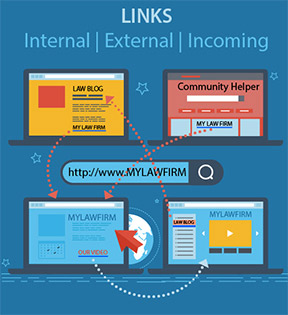Links & Your Website


Links are the mainstay of the Internet. They are what make it work. When you're browsing and come across a highlighted or underlined word, it's probably a link. Move your cursor over it and the arrow will turn into a little hand. Click on it and you will quickly go to another web page.
Why are Links Blue?
One story is that Tim Berners-Lee, the main inventor of the web, is the man who first made hyperlinks blue. Mosaic, an early web browser, displayed web pages with a gray background and black text. The darkest color available at the time that was easily distinguishable from the black text was that blue color. A practical reason is that blue is visible to most people, even the color blind.
Types of Links
- Internal link: A link between two pages on your website. Your website depends on those links for navigation throughout the site.
- External link: A link from your web page to another website. If there were no external links, there would be no Web since the World Wide Web is a network of web pages. You use external links to provide information to add to your content.
- Incoming links: A link from another website to your site—also called a backlink. The quantity and sources of the backlinks to your web page are among the factors that Google uses to evaluate your page ranking.
Using Links
Internal links attract the reader's attention, causing them to click through to other pages on your site, and satisfying their need for information while staying on your site. Start with great content, then add links to other articles, interesting videos, infographics, or images. Consider what information is most important to your potential client, and then use internal links to provide what they want.
Internal links also help search engines find your pages. Links should include descriptive words that relate to the destination page. This helps the search engine understand what your pages are about so they will be part of the answer to the prospective client's query.
Incoming and back links directing traffic to your site bring in more visitors. Links to your site from other sites are editorial votes telling the Internet community that your site has valuable information. Some ways to get others to link to you include:
- Volunteering in your community—being listed on their website includes link to your website.
- Use guest bloggers who will link to your blog.
- Write an article that includes a link to more information—that source will link back to you.
- Write about current events such as adding thoughts to an interesting trial that made the news. Being a regular source on current events will earn links.
Lastly, check your links to be sure they are working properly. Error responses will send mixed signals to your readers causing them to move on.
 Roberta Gubbins has served as the editor of the Ingham County Legal News. Since leaving the paper, she provides services as a ghostwriter editing articles, blogs, and e-blasts for lawyers and law firms. She is the editor of Briefs, the Ingham County Bar Association e-newsletter, and The Mentor, SBM Master Lawyers Section newsletter.
Roberta Gubbins has served as the editor of the Ingham County Legal News. Since leaving the paper, she provides services as a ghostwriter editing articles, blogs, and e-blasts for lawyers and law firms. She is the editor of Briefs, the Ingham County Bar Association e-newsletter, and The Mentor, SBM Master Lawyers Section newsletter.
Read More Clear & Convincing Articles
Using the New Enhanced Member Directory
How to Login and Edit Your Profile
Zeekbeek For Lawyers Page—learn about all the new directory features
How to Contact ZeekBeek Support